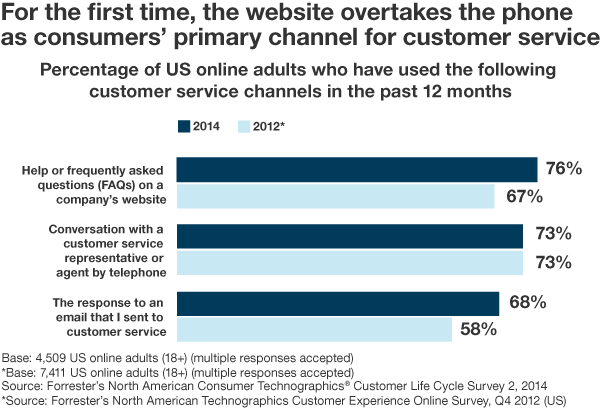The Data Digest: Customer Service Has Gone Digital
In the past week, I have booked a flight using a travel voucher, questioned a charge on my credit card bill, and bought an electric toothbrush. What do these experiences have in common? In each case, I had a relatively complex question and I received a helpful answer – without talking to anyone in person or by phone. Instead, with a little online research, I was able to identify which blackout dates applied to my travel voucher, clear the charge on my credit card bill, and learn the best settings for my toothbrush.
Essentially, I sought answers immediately by turning to digital channels first. In this regard, I’m not the only one. For the first time in the history of our research, more US online adults report using company websites than speaking with agents by phone when resolving customer service needs. Forrester’s Consumer Technographics® data shows that 76% of consumers turn to FAQ pages, and usage across other digital channels is growing notably:

The fact that technology is disrupting the way in which customers seek information is not merely a trend – it’s at a tipping point. In the age of the customer, consumers expect accurate answers with greater speed and less friction than before; as companies offer them detailed online content with increasingly effective navigation strategies, consumers will embrace self-service digital channels at the expense of offline communication.
In her recent report, my colleague Kate Leggett speaks to the challenge of keeping up with rapidly evolving digital behaviors. Kate reveals that there is a mismatch between consumer engagement behavior and customer service center operations. For example, “while consumers increasingly use digital channels . . . contact centers don’t deploy digital channels in proportion to their use. Those that do deploy these channels do not necessarily adopt best practices. It’s no wonder that among US online adults, a tenth of [online] chat users and a quarter of Twitter users are dissatisfied with customer service.”
The first step to solving a problem is to recognize there is one – but it’s just as important to understand why the problem exists in the first place. Customer insights professionals who keep a close eye on consumers’ online behaviors, motivations, and expectations will be better positioned to meet their imminent demands and deliver effective customer service in this digital age.
